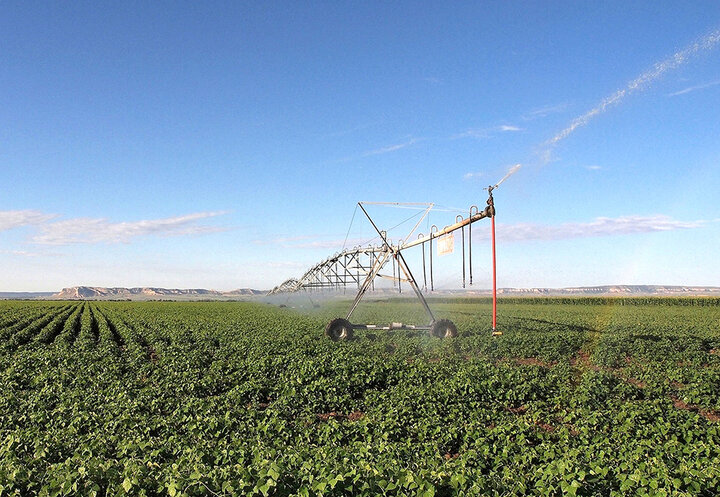This water series explores the people, places, and things that have been innovative in transforming water in Nebraska.
Related Articles:
The center pivot is the one invention that has changed the irrigated agricultural landscape worldwide. Center pivot irrigation has increased irrigation water use efficiency and reduced labor costs. It has also allowed agricultural development on marginal land with varying soil types and topography. Irrigated acres in Nebraska have increased from 3,998,000 acres (1960) to 9,378,462 acres (2022).
The general concept of a center pivot is a series of pipes connected by flexible couplers, supported by motorized structures (towers) that move the entire structure in a circle around the pivot point. The common means of power is the use of an electric motor on each tower to run the wheels, but there are systems that use water to do the same. The distance between the towers is called a “span,” usually 90 to 180 feet in length, and is supported by trusses. The length of each span can vary within the entire length of the pivot to match the contour of the land.
Sprinkler nozzles can be placed on top of the pipes or lower to the crop by using “drop pipes.” Nozzle spacing and nozzle orifice size are dependent on soil type, the amount of water infiltration rate of the soil, and the well capacity that can be pumped. The spray pattern and droplet size of the nozzle are also considered. Nozzle orifice size/water application rate increases further out from the pivot point because the pivot covers more area as it moves further out from the pivot point. Pressure regulators may be installed with the nozzles to provide uniform pressure for better uniform water application. An end gun/nozzle package can be installed at the end of the last span to irrigate more area. Some pivots have swing arm spans attached that swing out to irrigate the corners of a field.
Water is pumped to the pivot point and out through the nozzles on the spans to irrigate the crop. The water source can be a well near the pivot point or from a well outside the pivot, and it is pumped through a pipeline to the pivot point. In some cases, where surface water is used, a small pit or holding pond is dug outside the pivot. The surface water enters the pit and is pumped to the pivot point through an underground pipeline.
At the pivot point, there is a control box to turn the well pump on, set the direction of travel, and set the speed of travel for the pivot. It monitors the functions of the pivot, sending signals to the tower boxes located in each tower controlling the electric drive motors, telling them when to move, for how long, and in what direction. Power for the pivot can be from public power sources, diesel, natural gas or gasoline engines running a generator for power as well as serving to pump water from a well or holding pond.
Center pivots can be used to apply pesticides while applying irrigation water, called chemigation. To do so, the pivot system must have safety equipment installed. In Nebraska, the safety equipment includes a chemical supply tank with an agitator, chemical injection system, calibration tube and required safety devices. The approved, mandatory safety equipment includes an irrigation pipeline check valve, a vacuum relief valve, an inspection port, a low-pressure drain, a chemical injection line check valve, and a simultaneous interlock. Each center pivot that may chemigate must have all the mandatory safety equipment inspected and approved by the local Nebraska Natural Resources District. Everyone who performs chemigation must be certified by the Nebraska Department of Environment and Energy.

There are also lateral move irrigation systems, which are like center pivots but move in a straight line to irrigate rectangular fields. They have different guidance systems to keep them moving in a straight line. Water can be supplied by a ditch along the side of the field or from a flexible line attached to risers.
There were once over 75 center pivot/lateral move irrigation manufacturers. Some of the remaining companies in Nebraska include Valmont/Valley, Lindsay/Zimmatic, T-L Irrigation, and Reinke.
Who invented the center pivot? Frank Zybach, a farmer from Platte County, is the man who invented the center pivot. He designed and built his first system in 1948, applied for a patent in 1949, and the patent was awarded in 1952. Zybach went into partnership with A. E. Trowbridge to manufacture center pivots in Columbus, Nebraska, but the two friends had differences in philosophies about running the business. In 1954, the partners sold the manufacturing rights to Robert B. Daugherty of Valley Manufacturing — now called Valmont Industries, the oldest center pivot manufacturer. Valley Manufacturing engineers went on to make many improvements and innovations to the center pivot irrigation system and continue to do so today.
References
Evans, R. G., “Center Pivot Irrigation,” USDA-ARS, Sidney, MT
Kuszelka, R. D., Flowerday, C. A., Manley, Rundquist, B. C., Herrin, S. J., “Flatwater: A History of Nebraska and its Water,” University of Nebraska Conservation and Survey Division, Resource Report No. 12, March 1993
Martin, D., Kranz, W., Smith, T., Irmak, S., Burr, C., Yoder, R., “Center Pivot Irrigation Handbook,” University of Nebraska Biological Systems Engineering, February 2017
Nebraska Department of Environment and Energy, Nebraska Energy Statistics, Irrigated Acres in Nebraska 1964-2022

